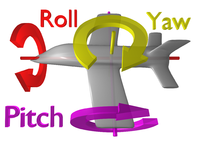The
flight of a UAV is
an interesting
thing. It is going
to involve the mass,
velocity,
acceleration, force
and a certain flight
equilibrium for the
aircraft to be able
to fly. The mass of
an UAV can range
from very light to
quite a bit. The
lightest UAV is
called the Delfly
Micro and weighs in
at 3.07 grams and
the heaviest UAV is
the High Altitude
Long Endurance
(HALE) and can
weight in at 12.5 kg
at its heaviest. The
velocity and
acceleration needed
to get both of these
UAV's and other
UAV's can also tend
to be large or
small. As stated by
dragonfly.com,
"Velocity is often
used as a synonym
for speed, but as
with mass and
weight, they are two
separate ideas." The
reason they are
different is because
velocity measures
not only the speed
of an object, but
also the direction
of that speed.
After the we figure out our velocity, we have to worry about the acceleration that comes along with UAV's. Acceleration simply informs people of the change of the velocity over a time interval. The acceleration of a UAV can be measured using an accelerometer and a normal DragonFlyer X6 UAV is normally measured around three accelerometers.
The next and very important part that helps a UAV take flight is Force. A force is not just one thing as Newton's Laws show us during Physics. As Randall D. Knight says it, "We refer to 'a force,' rather than simply 'force.' We want to think of a force as a very specific action, so that we can talk about a single force or perhaps about two or three individual forces that we can clearly distinguish, Hence the concrete idea of 'a force' acting on an object." Now when it comes to a UAV there are many different forces acting on a UAV. The forms of force that can act on a UAV, can range from gravitational force, normal force, drag force, thrust force, etc. These different forces can affect other areas of the UAV such as the UAV's roll, yaw and pitch.

After the we figure out our velocity, we have to worry about the acceleration that comes along with UAV's. Acceleration simply informs people of the change of the velocity over a time interval. The acceleration of a UAV can be measured using an accelerometer and a normal DragonFlyer X6 UAV is normally measured around three accelerometers.
The next and very important part that helps a UAV take flight is Force. A force is not just one thing as Newton's Laws show us during Physics. As Randall D. Knight says it, "We refer to 'a force,' rather than simply 'force.' We want to think of a force as a very specific action, so that we can talk about a single force or perhaps about two or three individual forces that we can clearly distinguish, Hence the concrete idea of 'a force' acting on an object." Now when it comes to a UAV there are many different forces acting on a UAV. The forms of force that can act on a UAV, can range from gravitational force, normal force, drag force, thrust force, etc. These different forces can affect other areas of the UAV such as the UAV's roll, yaw and pitch.

The other aspect that has a
great effectiveness on UAV's is the UAV's equilibrium.
According to dragonfly.com, "Equilibrium is a state of
motion where all forces balance, canceling each other
out exactly." The two forces that affect a hovering UAV
for example are gravity and thrust. These two forces
will have to cancel each other out to keep a UAV flying.
If the thrust gives out then the UAV is going to come
crashing to the ground and if the gravity gives out, we
are not going to be worried about the UAV as much as
ourselves. This can be seen in
the image below.


It is easy to see how the
physics of flight for an UAV and how without physics
the idea of flight would not be understood.
Introduction Slide UAV Payload UAV Building Bibliography
Introduction Slide UAV Payload UAV Building Bibliography